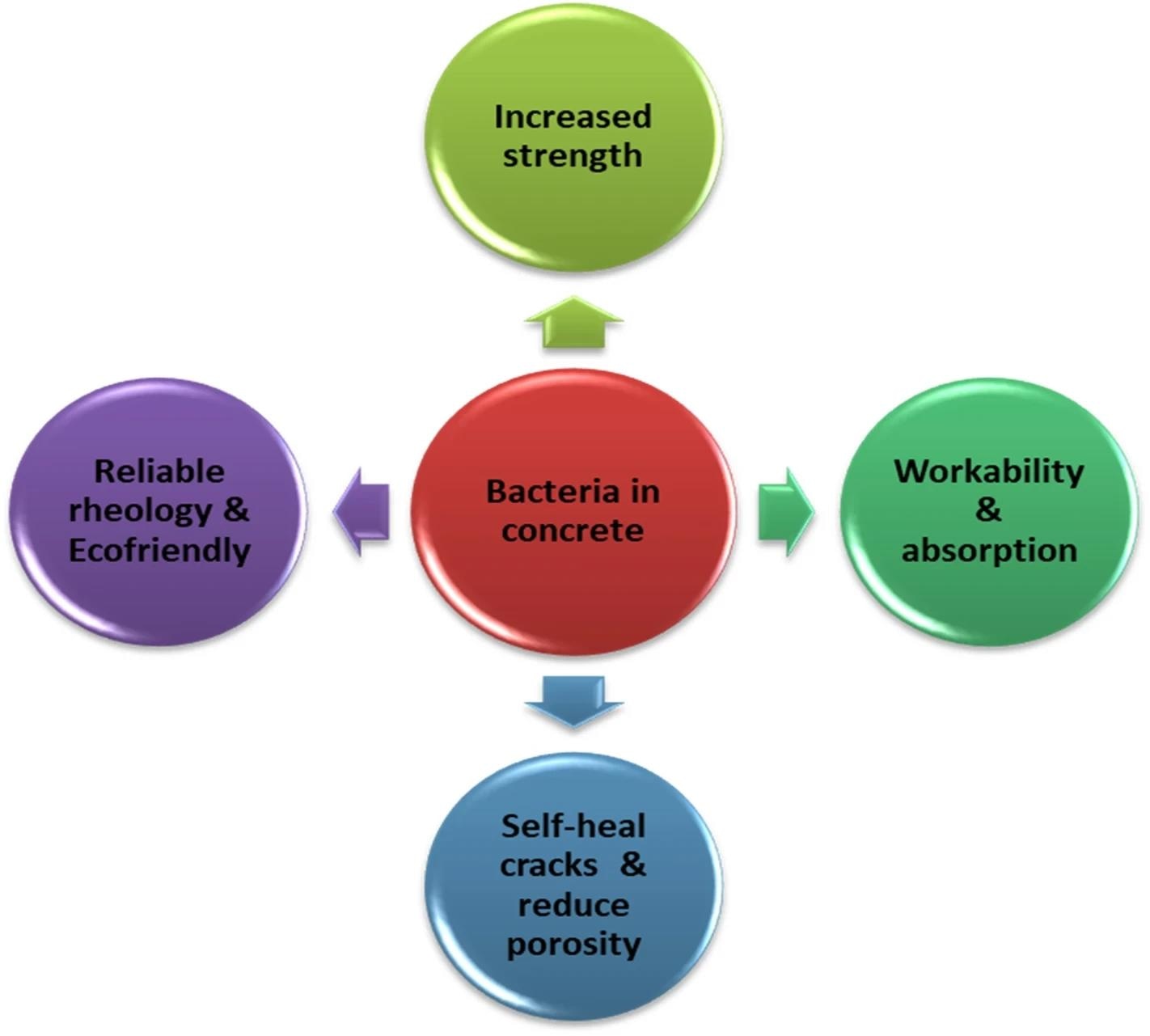In a paper published in the journal Scientific Reports, researchers have been exploring the efficacy of various metaheuristic techniques alongside response surface methodology (RSM) in predicting the mechanical properties of self-healing concrete (SHC).
 Structural benefits of bacillus subtilis in concrete. https://www.nature.com/articles/s41598-024-58666-8
Structural benefits of bacillus subtilis in concrete. https://www.nature.com/articles/s41598-024-58666-8
The study aimed to streamline the design process and reduce costs associated with creating a conducive environment for bacteria growth in self-healing concrete by leveraging gray wolf optimization (GWO), multi-verse optimization (MVO), moth fly optimization (MFO), particle swarm optimization (PSO), and whale optimization algorithm (WOA), coupled with RSM.
The results indicated that these metaheuristic techniques surpassed RSM due to their ability to mimic genetic mutation processes.
Background
Past work has focused on developing SHC, which utilizes bacteria to repair cracks and damage autonomously. Understanding the influence of bacteria concentration on SHC's mechanical properties is crucial for sustainable bio-concrete design. Optimizing bacteria concentration can enhance SHC's healing efficiency, structural integrity, and long-term durability, thus advancing the field of sustainable construction.
Analyzing SHC Properties
The study utilized a dataset compiled from previous research and conducted preliminary analyses to understand the relationship between bacteria concentration and the mechanical properties of SHC. Descriptive statistics and visualization tools, such as violin plots and correlation matrices, were employed to depict the data distribution and relationships between variables.
Linear multivariate regression (LMR), RSM, GWO, MVO, MFO, PSO, and WOA were employed to forecast the effect of bacteria concentration on mechanical properties. These advanced metaheuristic techniques are known for their precision, robustness, and efficiency in modeling complex systems.
LMR, a statistical technique, was used to model the relationship between multiple independent and dependent variables. The aim was to find a linear equation that predicts the dependent variable based on the values of independent variables. LMR extends simple linear regression to multiple independent variables, commonly used in various fields for predictive modeling and understanding variable relationships.
RSM, a collection of statistical techniques, was employed to model and analyze the relationship between controlled independent variables and the observed response of the system. It constructs mathematical models to predict optimal process conditions and understand interactions between input variables, often used in engineering and chemistry to optimize processes and improve product quality.
The investigators utilized advanced optimization algorithms like GWO, MVO, MFO, PSO, and WOA to optimize the forecasting models. These algorithms efficiently explore solution spaces and converge toward optimal solutions, making them widely applied across various domains for solving complex optimization problems effectively. The process employed statistical techniques and advanced optimization algorithms to model the relationship between bacteria concentration and SHC's mechanical properties. By leveraging traditional and cutting-edge approaches, the study aimed to provide insights into optimizing bio-concrete production for sustainable and green construction practices.
RSM Analysis Summary
The analysis of RSM for the compressive, flexural, slump (Sl), and splitting tensile strength of SHC reveals significant insights into the predictive models. The model exhibits high compressive strength (CS) significance, with several considerable model terms indicating a strong fit. Similarly, flexural strength (FS) and Sl models show significant results, though they are influenced by slightly different factors.
Adequate precision is observed across all models, indicating reliable signal-to-noise ratios, enabling effective design space navigation. GWO and MFO were utilized to improve predictions, demonstrating advancements over traditional multilinear regression methods.
Sensitivity analysis highlights each parameter's varying degrees of influence on concrete properties. For instance, bacterial concentration is crucial across different properties, underscoring its significance in SHC's behavior. It aligns with previous research findings and underscores the importance of precise control over such constituents in achieving desired concrete characteristics. Moreover, the comparison to prior studies utilizing different self-healing methods emphasizes the effectiveness of metaheuristic techniques in overcoming overfitting and improving prediction accuracy.
Metaheuristic techniques, in contrast to traditional methods like RSM and LMR, exhibit superior predictive capabilities. This superiority stems from their nature-inspired algorithms and resilience to overfitting. Although RSM offers adequate precision, metaheuristic approaches provide more accurate predictions. Such accuracy is crucial for optimizing concrete properties, free from the constraints typically associated with conventional regression techniques.
Conclusion
To sum up, the team investigated the impact of bacteria concentration on the mechanical properties of SHC using advanced metaheuristic techniques like GWO, MVO, MFO, PSO, and WOA in conjunction with RSM. They found that these metaheuristic methods outperformed RSM, with GWO excelling in predicting concrete Sl, PSO performing best in forecasting FS, and MVO outperforming others in predicting CS.
Sensitivity analysis revealed the significant influence of bacterial concentration on SHC's behavior. Overall, GWO, PSO, and MVO demonstrated superior predictive capabilities, while RSM provided adequate precision for predicting SHC's mechanical properties through polynomial relationships.
These findings highlight the potential of advanced optimization methods to refine predictive models and enhance the design of self-healing concrete for sustainable infrastructure development. Future endeavors may explore hybrid approaches integrating metaheuristic algorithms and traditional methodologies to optimize SHC properties further and advance construction materials engineering.
Journal Reference
Onyelowe, K. C., et al. (2024). Modeling the Influence of Bacteria Concentration on the Mechanical Properties of Self-Healing Concrete (SHC) for Sustainable Bio-Concrete Structures. Scientific Reports, 14:1, 8414. https://doi.org/10.1038/s41598-024-58666-8, https://www.nature.com/articles/s41598-024-58666-8.
Disclaimer: The views expressed here are those of the author expressed in their private capacity and do not necessarily represent the views of AZoM.com Limited T/A AZoNetwork the owner and operator of this website. This disclaimer forms part of the Terms and conditions of use of this website.
Article Revisions
- Apr 19 2024 - Title changed from "Self-Healing Concrete Design with Metaheuristic Techniques" to "Enhancing Self-Healing Concrete with Advanced Metaheuristic Techniques"